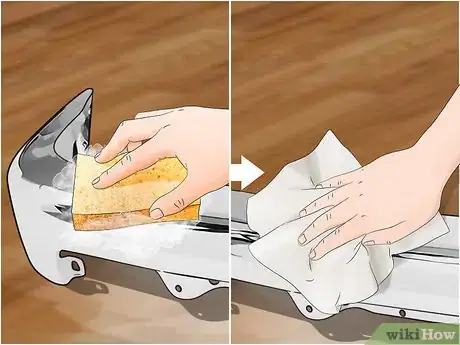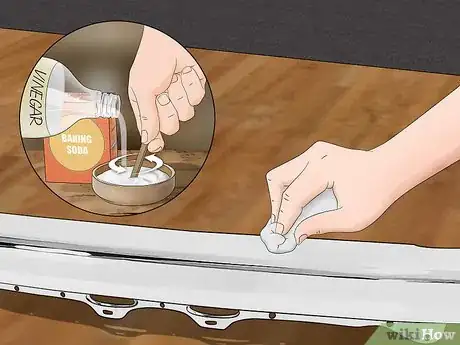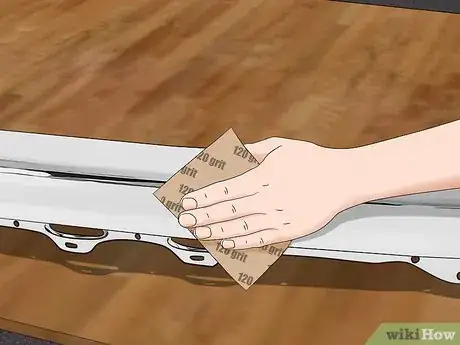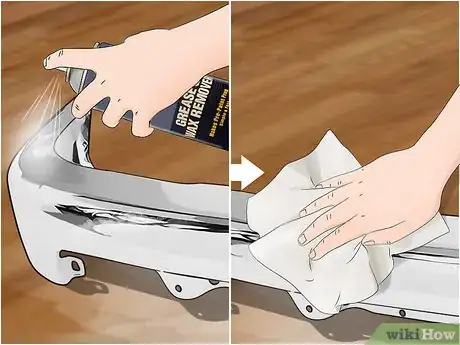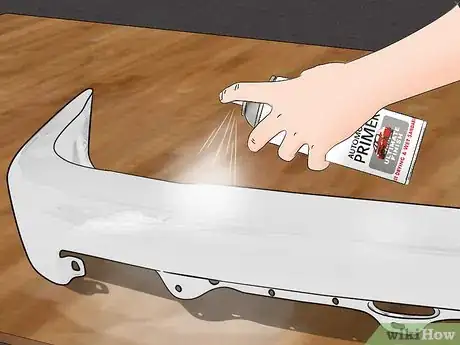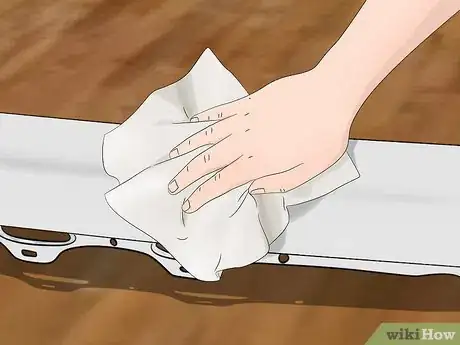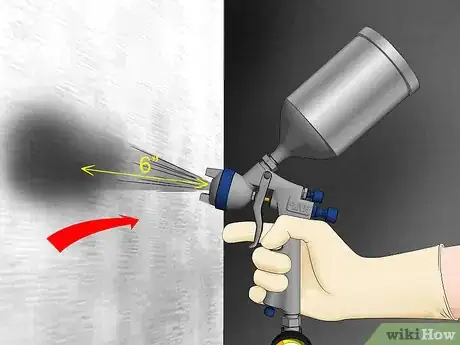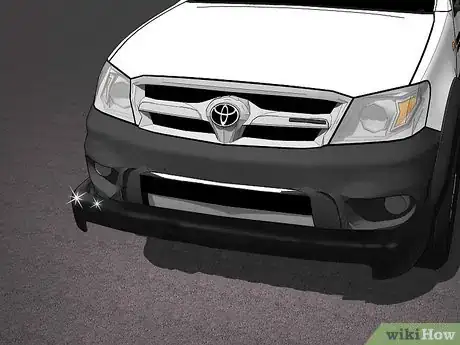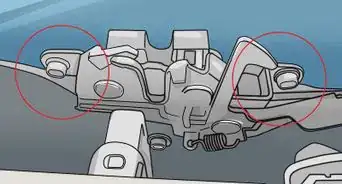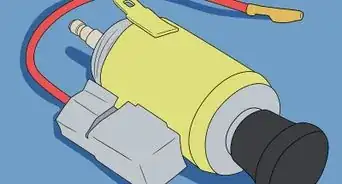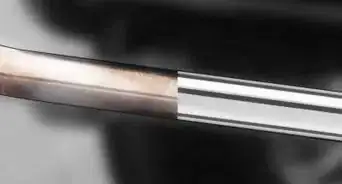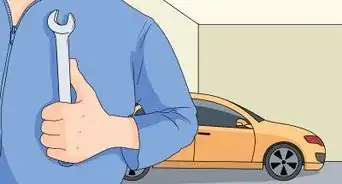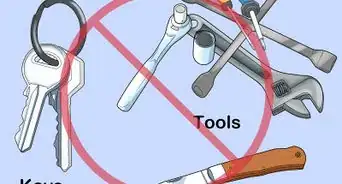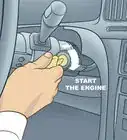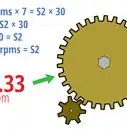This article was co-authored by wikiHow Staff. Our trained team of editors and researchers validate articles for accuracy and comprehensiveness. wikiHow's Content Management Team carefully monitors the work from our editorial staff to ensure that each article is backed by trusted research and meets our high quality standards.
There are 9 references cited in this article, which can be found at the bottom of the page.
This article has been viewed 91,149 times.
Learn more...
Maybe your chrome bumper has rusted, or you’re just not a fan of that shiny silver color. Painting over chrome isn’t like painting over regular metals — if you paint directly on top of it, you’ll end up with flaking paint and a sad-looking bumper. By making sure the bumper is clean, priming the chrome, and sanding its surface, you’ll have a painted chrome bumper ready for its next drive.
Steps
Preparing the Surface for Primer
-
1Remove the bumper from the vehicle. Removing the chrome bumper from your car will make it easier for you to carry out the process of painting it. To remove your front bumper, open your hood to find the screws and bolts that connect your bumper to the front of your car and remove these screws. Your rear bumper is also attached with screws and bolts, most of which are on the outside, so you simply unscrew these to remove it.[1]
-
2Wash the chrome bumper with soap and water. You want to make sure you remove all of the fingerprints, dust, or dirt that is on the bumper’s surface. Wash the bumper thoroughly with soap and water, and then carefully dry the bumper so that it’s no longer damp.[2]Advertisement
-
3Remove rust from the bumper if necessary. Chrome rusts easily, so if your bumper is rusty you’ll need to remove the rust before you can start painting. To do this, mix vinegar and baking soda together until they form a thick paste. Take a rag or some sort of cloth and cover the rusted area with the paste. Let it sit for about 5 minutes, and then use steel wool to rub the rust off of the bumper.
- The vinegar and baking soda mixture should cause the rust particles to loosen. If your bumper still shows signs of rust, repeat the process over again.
- Wipe down the bumper with water or soap once you’ve removed the rust to be sure to have a nice clean surface.[3]
-
4Sand the entire chrome bumper evenly. To apply paint to your bumper, you need to create a workable surface for the primer. Use sandpaper or a dual action sander to remove any imperfections. Start with a coarser sandpaper, such as 60- or 120-grit, and then use 320-grit paper for a finer finish. The goal is to remove the shiny quality from the chrome surface.[4]
- If you need to remove flaking spots, deep scars, or do heavy sanding, you should use 40- to 60-grit paper.
- For fixing small imperfections, try 80- to 120-grit paper.
- For a very smooth surface, use 360- to 600-grit paper. This should leave you with a surface without many scratches.
-
5Wipe down the bumper using grease and wax remover. Grease and wax remover will get rid of any additional traces of dirt, oil, grease, and other contaminants. Remnants of dirt will cause a bad paint job, so be sure to wipe the bumper with wax and grease remover thoroughly, and then dry it off with a clean rag.[5]
- Grease and wax remover can be purchased at a home improvement store, auto shop, or online.
-
6Cover any areas of the bumper you don’t want painted with tape. If there’s a part of the car or bumper that you don’t want to paint over, use painter’s tape or plastic to cover up this section. If using painter’s tape, make sure that the edges are pressed down firmly and evenly.
Priming the Chrome Bumper
-
1Set up your work area and safety gear. Paint fumes and aerosol sprays aren't very healthy to breathe in, so make sure you're working in a ventilated area. You can set up a ventilated spray booth and wear a respirator, or use a local exhaust ventilation system. Wearing gloves and eye protection are important safety precautions as well.[6]
-
2Spray the chrome bumper with self-etching primer. The self-etching primer is what will allow the regular primer to grab hold of the metal. Cover the entire bumper with the self-etching primer, spraying 2-3 even coats. Allow each coat to dry completely before continuing.
- When spraying in between layers, self-etching primer should only take a couple of minutes to dry. Allow the last coat to sit for 3-4 hours before starting to sand.
-
3Spray the bumper with regular automotive primer. The regular primer will help to bond the paint to the chrome, strengthen the metal, and prevent rusting, so don’t just use the self-etching primer and not the regular one as well. Cover the entire surface evenly using 2-3 coats, and wait for each coat to dry before applying the next one.[7]
- Depending on which type of primer you're using and what kind of paint you'll be using on top, the regular primer's drying time will vary. Check the instructions on the primer to see how long to let it sit.
-
4Sand the primer without touching the chrome surface. Once your bumper’s primer is completely dry, you can start sanding. The purpose of this sanding is to smooth out the surface of the primer while not getting to the chrome layer, so only use a very fine sandpaper (400- to 600-grit) for this step.[8]
- If you do happen to sand through the primer and reach the chrome surface, re-apply the primer, let it dry, and sand again.
-
5Wipe away any dust or residue from the primer. Use a cloth to wipe off any dust particles left over from sanding. You don’t want any dirt left on your bumper, as this will affect how the paint sticks to the surface. To avoid accidentally removing the primer, be gentle when wiping.
- You can use water, lacquer thinner, or a wax and grease remover to wipe away the dust.
Applying the Paint and Finishing Touches
-
1Practice your spraying technique. If you've never used a spray gun before, practicing on a scrap piece of metal is a good idea. Hold the spray gun 6 inches (15.2 cm) away from the surface of the metal, and spray the paint back and forth in even motions. To avoid drips or areas with heavy paint, only press down on the paint trigger when your arm is in motion.[9]
- If you do have drips, you can use 2000-grit wet sandpaper to gently sand down the paint run.
-
2Spray the paint onto the bumper in light, even coats. Once you're confident in your spraying technique, apply the paint in an even layer over the bumper. Use 3-4 coats, and make sure to check for any drips that will take away from the paint’s appearance. Let each coat dry entirely before adding an additional one.
- For correct drying times, check your paint's directions to see how long to wait between coats.
-
3Apply clear coats to the painted bumper. After you’re satisfied with the bumper’s color and all of the paint coats have dried, apply 2-3 clear coats evenly. While mostly referred to as car clear coats, they're also called top coats or high glosses. The clear coat will help preserve the color, as well as protect the bumper from sun damage, chipping, dirt, chemicals, and many other things that could harm your bumper’s surface.[10]
-
4Reattach the bumper to your vehicle once it’s completely dry. Once your bumper’s final coat is dry, you’re ready to reattach it to your vehicle! Reattach the screws and bolts to the bumper and inspect your newly-finished paint job.
Warnings
- Wear correct protection while using any sanding equipment, primer, or paint, and always carry out the steps in a ventilated area.⧼thumbs_response⧽
Things You'll Need
- Ventilation system
- Safety gear
- Wrench
- Screw driver
- Soap
- Dry cloths
- Painter's tape
- Grease and wax remover
- Sandpaper or dual action sander
- Self-etching primer
- Automotive primer
- Paint color
- Clear coat
References
- ↑ https://itstillruns.com/off-car-bumper-4910451.html
- ↑ https://itstillruns.com/paint-chrome-bumpers-4895495.html
- ↑ https://itstillruns.com/paint-over-rusted-chrome-7791232.html
- ↑ https://www.todayshomeowner.com/video/how-to-choose-the-right-sandpaper-grit-for-the-job/
- ↑ https://www.learnautobodyandpaint.com/the-importance-of-wax-and-grease-remover-on-auto-undercoat-and-top-coat/
- ↑ https://www.epa.gov/sites/production/files/2015-06/documents/breathing_easy.ensuring_proper_ventilation_of_paint_mixing_rooms_in_auto_refinish_shops_.pdf
- ↑ https://www.thoughtco.com/prime-before-paint-car-281675
- ↑ https://itstillruns.com/paint-chrome-bumpers-4895495.html
- ↑ http://www.popularmechanics.com/cars/how-to/a3110/a-diy-guide-to-painting-your-car-15998013/
About This Article
To paint chrome bumpers, start by removing the bumpers from your vehicle and cleaning them thoroughly. Then, working in a well-ventilated area, spray the bumpers with 2-3 coats of self-etching primer and 2-3 coats of regular automotive primer, letting them dry in between coats. Next, sand the bumpers with 400- or 600-grit sandpaper to smooth out the primer, then wipe away any dust. After that, use a spray gun to apply 3-4 coats of your desired paint. Finally, apply 2-3 clear coats over the paint to preserve the color and protect the bumpers. To learn more, including how to use your spray gun without leaving drips, scroll down!

